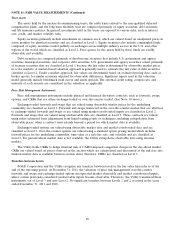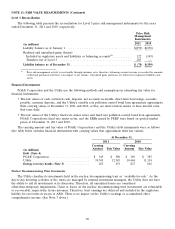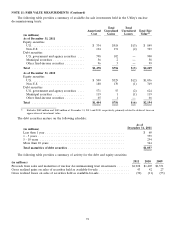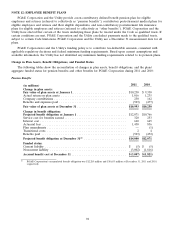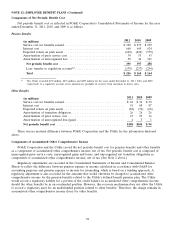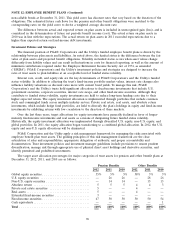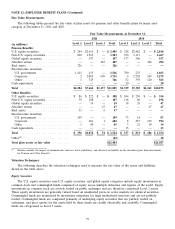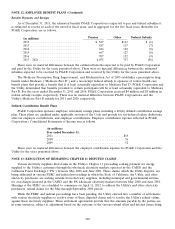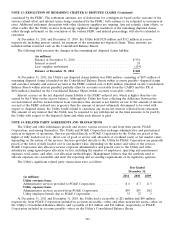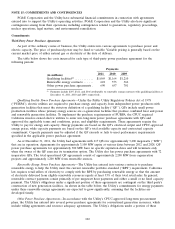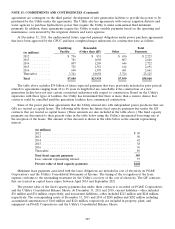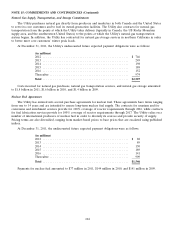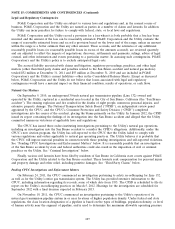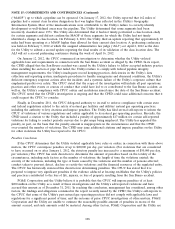PG&E 2011 Annual Report Download - page 102
Download and view the complete annual report
Please find page 102 of the 2011 PG&E annual report below. You can navigate through the pages in the report by either clicking on the pages listed below, or by using the keyword search tool below to find specific information within the annual report.NOTE 12: EMPLOYEE BENEFIT PLANS (Continued)
Absolute Return
The absolute return category includes portfolios of hedge funds that are valued based on a variety of proprietary
and non-proprietary valuation methods, including unadjusted prices for publicly-traded securities in active markets.
Hedge funds are considered Level 3 assets.
Real Assets
The real asset category includes portfolios of commodities, global real estate investment trusts (‘‘REITS’’),
global listed infrastructure equities, and private real estate funds. The commodities, global REITS, and global listed
infrastructure equities are actively traded on a public exchange and are therefore considered Level 1 assets. Private
real estate funds are valued using pricing models and valuation inputs that are unobservable and are considered
Level 3 assets.
Fixed-Income
The fixed-income category includes U.S. government securities, corporate securities, and other fixed-income
securities.
U.S. government fixed-income primarily consists of U.S. Treasury notes and U.S. government bonds that are
valued based on quoted market prices or evaluated pricing data for similar securities adjusted for observable
differences. These securities are categorized as Level 1 or Level 2 assets.
Corporate fixed-income primarily includes investment grade bonds of U.S. issuers across multiple industries that
are valued based on a compilation of primarily observable information or broker quotes in non-active markets. The
fair value of corporate bonds is determined using recently executed transactions, market price quotations (where
observable), bond spreads or credit default swap spreads obtained from independent external parties such as vendors
and brokers adjusted for any basis difference between cash and derivative instruments. These securities are classified
as Level 2 assets. Corporate fixed-income also includes commingled funds comprised of private corporate debt
instruments and insurance contracts for deferred annuities. These investments are valued using pricing models and
valuation inputs that are unobservable and are considered Level 3 assets.
Other fixed-income primarily includes pass-through and asset-backed securities. Pass-through securities are
valued based on benchmark yields created using observable market inputs and are Level 2 assets. Asset-backed
securities are primarily valued based on broker quotes and are considered Level 2 assets. Other fixed-income also
includes municipal bonds and futures. Municipal bonds are valued based on a compilation of primarily observable
information or broker quotes in non-active markets and are considered Level 2 assets. Futures are valued based on
unadjusted prices in active markets and are Level 1 assets.
Cash Equivalents
Cash equivalents consist primarily of money markets and commingled funds of short-term securities that are
considered Level 1 assets and valued at the net asset value of $1 per unit. The number of units held by the plan
fluctuates based on the unadjusted price changes in active markets for the funds’ underlying assets.
Transfers Between Levels
PG&E Corporation and the Utility recognize any transfers between levels in the fair value hierarchy as of the
end of the reporting period. As shown in the table below, transfers out of Level 3 represent assets that were
previously classified as Level 3 for which the lowest significant input became observable during the period. No
significant transfers between Levels 1 and 2 occurred in the years ended December 31, 2011 and 2010.
98



